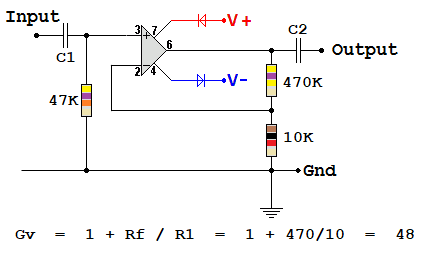
| A Level Audio Power and RMS >Pre-Amplifier< Push-Pull Tone Controls |
Audio Pre-Amplifier |
|
Audio pre-amplifiers often have an input impedance of about 47kΩ designed to match most other audio devices. For top quality the amplifier frequency response should cover at least the range of human hearing from 20 to 20,000 Hz.
If you select an op-amp with a gain bandwidth product of 1 MHz, the gain has to be limited to 50 or less or the high frequency performance will not meet the specification.
50 x 20,000 Hz = 1 MHz.
To get a pre-amp with more gain than this, two pre-amplifier circuits could be used or a higher performance chip could be specified.
Op-amp preamplifiers might suffer from input noise adding a hiss to the output. The commonly used 741 chip is not especially good in this respect. Other lower noise op-amps are available. Low noise transistors could also be used instead of an op-amp.
The 47K resistor reduces the almost infinite input resistance.
The gain is set to 48, just below the limit of 50.
The chip is a version of the 741 chip with a gain bandwidth product of 1 000 000.

C1 with the 47K resistor forms a passive high pass filter. To ensure it passes frequencies as low as 20 Hz, the capacitor must be calculated for that break frequency. The output will drop to 0.707 of maximum at this frequency.
Xc = R = 1 / ( 2 Pi F C ) = 47 000
C1 = 1 / ( 2 x Pi x 47 000 x 20 ) = 169 nF The nearest commonly available capacitors are 220nF or 470nF. Using 470nF, the break frequency is about 9 Hz giving a comfortable margin of error.
C2 can be the same assuming the next subsystem input also has a 47K input resistance.
Subject Name Level Topic Name Question Heading First Name Last Name Class ID User ID
|
Q: qNum of last_q Q ID: Question ID Score: num correct/num attempts Date Done
|
Question Text
image url
Help Link
Add Delete Clone Edit Hardness
Contact, Copyright, Cookies and Legalities: C Neil Bauers - reviseOmatic V4 - © 2016/17
Hosted at linode.com - London
Please report website problems to Neil